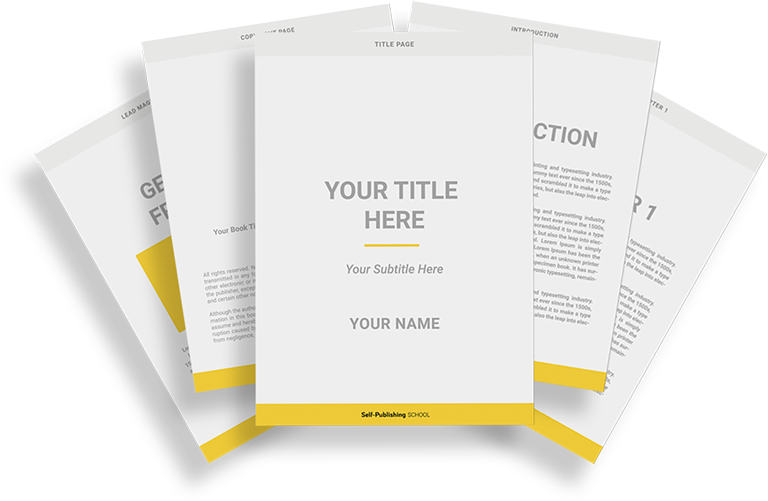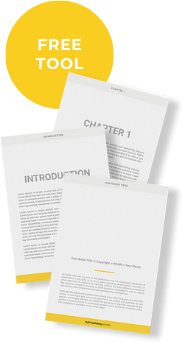Sometimes a story requires a flashback—if you can’t start at the beginning, maybe you just throw the beginning somewhere in the middle.
BUT!
Do you need to tell the beginning at all? In this blog, we’re going to learn about flashbacks and if your story really needs them.
Some good reasons to use flashbacks:
- To tell your story in a more compelling and clever way
- To allow your reader to get invested before you go back to cover the less exciting requirements of your story
- To postpone revealing information for intrigue or flow
These are all fine reasons to employ a flashback, but let’s talk about when you should and when you shouldn’t use them.
Here’s what we’ll cover for how to write flashbacks:
- What are flashbacks?
- How to write flashbacks
- Examples of flashbacks


Book Outline Generator
Choose your Fiction or Nonfiction book type below to get your free chapter by chapter outline!
Book Outline Generator
Enter your details below and get your pre-formatted outline in your inbox and start writing today!
CONGRATULATIONS
Thanks for submitting! Check your email for your book outline template.
In the meantime, check out our Book Outline Challenge.

What are flashbacks?
Flashbacks are simply flashes back to an earlier event in a story’s narrative. They can occur at any point in a story. Most prologues are flashbacks.
Flashbacks can be tricky little guys to nail, especially in written works. I see a lot of inexperienced writers mess them up big time.
They’re either too frequent, overdone, too long, irrelevant, or awkwardly shoved into a scene they have no business interrupting.
Let’s look at ways to use flashbacks effectively.
How to write flashbacks
So what’s the best way to write a flashback? When do you use them, when do you not use them, and how do you use them well?
Here are five tips to help you write flashbacks.
#1 – Earn your flashback
If you throw in a long flashback too early in the story, you run the risk of your reader not being interested. Are they invested enough in the story to hop back in time with you? If your flashback is longer than a page or two, it may turn readers off if they haven’t grown attached enough to your characters and your story to care about extra information, like a flashback.
Save your flashbacks for a point in the story when your readers should be invested enough to time travel.
Smoothly transition into and out of your flashback.
You don’t want a flashback out of nothing. Just like a regular scene, write transitions to help it flow as a cohesive piece. A great way to do transition is with a trigger, like a character hears a word, sees a flash of something familiar, smells, tastes, feels something that reminds them of the time they’re flashing back to. This provides a logical bridge from the main storyline to the flashback.
Transitioning back out of it can be as simple as someone in the present-time saying, “Hello?” You need something to jog the character back into the present. Clear edges of the flashback gives your reader the stability they need to follow along.
On the flip side of that, negating the transitions is a great way to intentionally make your audience uncomfortable or confused. I’ll explain that in a bit.
#2 – Make sure the flashback is relevant and necessary
Don’t hop around in your timeline for no reason. It’ll make your story more difficult to follow. If you’re using a flashback, employ the same rules we mentioned for prologues:
Is it crucial for the reader’s understanding? If no, don’t use it.
Does it make sense without it? If yes, don’t use it.
Can you weave the information into a regular scene instead? If yes, don’t use it
#3 – Use the flashback sparingly
And use your flashbacks sparingly. Flashbacks are a need-to-include element in a written story because it takes more effort for the reader to settle into a flashback scene.
Carefully critique your flashback scenes for necessity and relevance.
#4 – Keep the flashback brief
You don’t need pages and pages of backstory—most of that should be worked into your regular timeline.
If you’re sure the flashback is relevant and necessary, then you should be able to hit your point quickly and get out before it drags on for too long.
#5 – Make the flashback meaningful
Your flashbacks should carry weight—they shouldn’t just be exposition or a convenient way to pass information to your reader.
Like we said, it takes effort on the reader’s part to keep up with a flashback. Don’t make them do extra work for no payoff.
Types of flashback
There are essentially two main types of flashback: A full flashback scene or a brief in-scene flashback.
For a full flashback, you need transitions, as mentioned above. Something to trigger the beginning of the flashback, something to trigger the end, and likely scene breaks or a chapter change to separate it from the original timeline. These scenes are much longer and cover a lot more ground than an in-scene flashback.
The more common flashback in novels and short stories is the in-scene flashback. Let’s look at a couple of examples to see how they’re woven into scenes without pulling the reader away from the present for a significant amount of time.
I mentioned above that sometimes you may want to confuse your audience. Here’s an excerpt from the short story, Wolverine Frogs (TW: sexual assault):
The warm sun and humidity hit my face like opening a dryer mid-cycle. I step onto the sidewalk and start down the street.
“Maya, wait up!” Andre is buttoning his shirt and running toward me barefoot.
I keep walking. “I have to get back before next period.”
“Wait.” He grabs my arm. “Maya, just look at me.”
I was pinned to the ground in the dim room, fingernails digging into the wooden floorboards, red light blinking in front of my face.
“Just look at me,” the man said through gritted teeth.
I closed my eyes tight.
“Look at me!”
I was on my stomach and he was on top of me and I couldn’t look at him if I tried. My fingers were white, gripping at the cracks on the floor.
I press my hands into the floor and push up as hard as I can. He falls off and I face him. I lunge and dig into his skin, tearing at his eyes with claws I didn’t know I had.
“Maya, stop!” Andre cries.
I’m outside, in the sun. A bird sings somewhere.
This flashback is weaved into the scene because the character is experiencing PTSD in the form of a triggered flashback. She’s confused about when and where she is, so the reader is confused about when and where they are.
The transition is subtle, indicated by switching from present to past tense. The scene is in the present tense, then, “I was pinned to the ground in the dim room,” gives us a time and scene shift. She was outside, now she’s not. It’s confusing, but clear enough to follow.
This scene isn’t set apart by a full flashback with scene breaks because it’s meant to be extremely brief and confusing. The reader is just as displaced and lost as the character.
Let’s look at an example of an in-scene flashback that isn’t intentionally confusing for the reader from Landline by Rainbow Rowell:
Her mom had turned Georgie’s childhood bedroom into the pug trophy room as soon as she graduated from high school—which was irritating because Georgie didn’t actually move out of the house until she graduated from college.
“Where else am I supposed to display their ribbons?” her mom had said when Georgie objected. “They’re award-winning dogs. You’ve got one foot out the door anyway.”
“Not currently. Currently, I have both feet on my bed.”
“Take off your shoes, Georgie. This isn’t a barn.”
This isn’t a full scene—just a bit of dialogue. It’s triggered by Georgie walking into her childhood room and remembering a conversation she’d had with her mother. It’s indicated with italics and past perfect tense (while the rest of the scene is in the past tense).
The flashback shows Georgie’s dynamic with her mother. It’s much quicker and easier to slip in while Georgie is entering her room, because it was already necessary for her to do so, and to show the relationship with her mom may have required an additional scene. This flashback saves a little time.
Flashback examples
Flashbacks most often occur in visual storytelling, like movies, TV shows, and comic books. Let’s look at some examples.
— Flashbacks in movies examples
Flashbacks are most commonly found in screen media. Many films are nearly entirely flashback, like:
- Forrest Gump, where Forrest tells his life story to random people who sit with him on the bench. This narrative scope serves several purposes: showing how people react to Forrest, how he’s accepted, and how he’s open to being friends with anyone. It’s characterizing and sets the tone for the film.
- Titanic is told in a flashback from the perspective of elderly Rose. This narration leads to intrigue. We know that she survives, but we don’t know what happens to Jack until the end of the movie.
- The Notebook is told in a flashback as Noah reads their story to dementia patient, Allie, from her own journal. This is stupid and serves no real purpose, which fits the quality of the rest of the story.
—Flashbacks in TV shows examples
One of the most popular flashback styles is from the TV show LOST. The audience could keep track of flashbacks by the characters and setting changing appearance, but also by the signature “whoosh” to indicate we were hopping back in time. (Here it is, if you’ve somehow been able to forget.)
—Flashbacks in books examples
Flashbacks in books aren’t nearly as common as they are in TV shows and movies. It’s much easier to transition between timelines in a visual medium—with books, you really have to work for it.
The Book Thief by Markus Zusak flashes back and forward through the character’s story to create suspense and intrigue.
Other stories that famously employ flashbacks are To Kill a Mockingbird, The Five People You Meet in Heaven, and The Odyssey.
Flashbacks are one more tool writers can use to build a compelling and impactful story, but they’re tricky! Use these tips to make intentional choices about the structure of your timeline so you can utilize flashbacks in a way that helps readers connect with the story.


Book Outline Generator
Choose your Fiction or Nonfiction book type below to get your free chapter by chapter outline!
Book Outline Generator
Enter your details below and get your pre-formatted outline in your inbox and start writing today!
CONGRATULATIONS
Thanks for submitting! Check your email for your book outline template.
In the meantime, check out our Book Outline Challenge.

